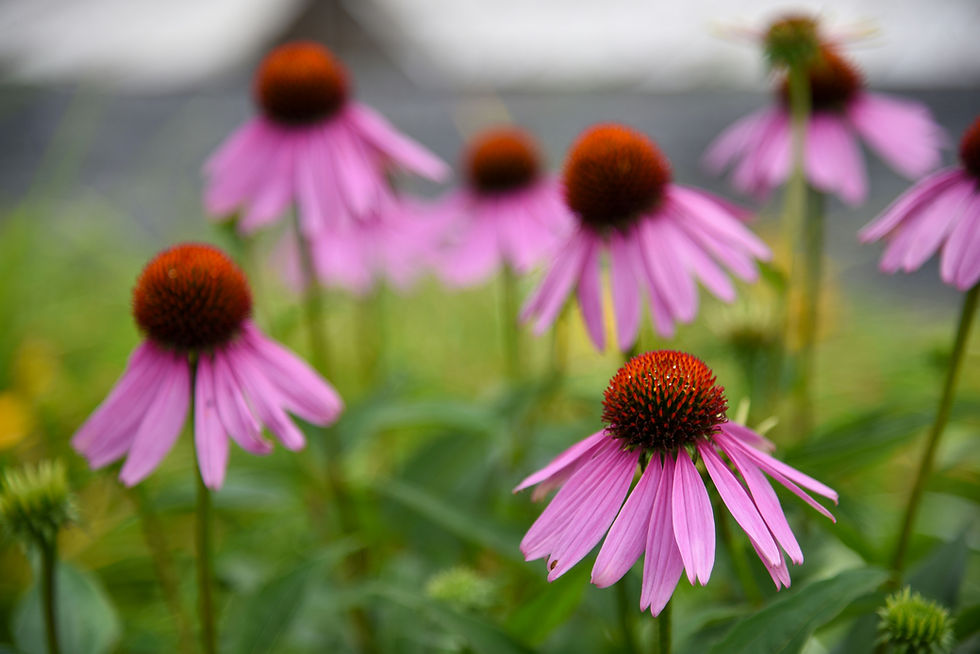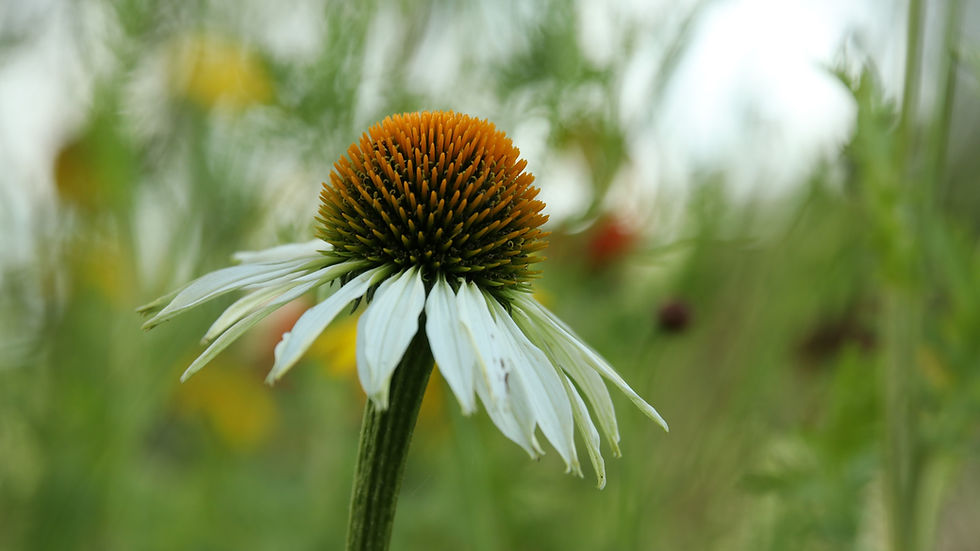Coneflower (Echinacea) – The Resilient Beauty of the Cottage Garden
- May 1
- 3 min read
Updated: 3 days ago
Coneflowers (Echinacea) are more than just pretty faces in the summer garden. With their bold spiky central cones and daisy-like petals, these sturdy, sun-loving perennials are as resilient as they are beautiful, thriving in a variety of soil types and attracting a symphony of pollinators. They add a touch of rustic elegance to cottage gardens and wildflower meadows alike.

Why Coneflowers Belong in Every Cottage Garden
Whimsical Wildflower Charm – With its daisy-like petals and bold, raised centers, the coneflower (Echinacea) brings a joyful, untamed spirit to the garden. Its soft yet striking presence evokes the feel of meadows and woodland edges—natural, free-flowing, and beautifully imperfect. The slightly drooping petals give it a relaxed elegance that complements a cottagecore aesthetic rooted in simplicity and romanticism. Whether in soft pinks, purples, or even white, coneflowers add nostalgic, storybook charm to any garden.
Heirloom Herbal Traditions – Cherished for generations, coneflowers were a staple in Native American and early herbalist medicine cabinets. Known especially for their immune-boosting properties, Echinacea root and flowers were brewed into teas and tinctures to ward off illness, making them both a functional and symbolic plant of healing and resilience. Growing them in your garden creates a connection to those traditions of self-sufficiency and natural wellness. For the cottagecore soul, coneflower offers both beauty and practical use.
A Pollinator’s Delight – Coneflowers hum with life—bees adore them, butterflies flock to them, and even goldfinches come for the seeds once blooms fade. Their nectar-rich centers serve as a feast for pollinators throughout the summer, making them an essential feature for those hoping to create a garden that gives back to the surrounding eco-system. A thriving coneflower patch supports biodiversity and encourages a harmonious rhythm between flora and fauna—one of the core ideals of the cottagecore lifestyle.
Resilient & Low-Maintenance – Tough and drought-tolerant, coneflowers thrive even when conditions are less than ideal. Once established, they handle dry spells with grace, bloom through heat, and return year after year with very little fuss. Their strong, upright stems don’t require staking, and they resist deer and most pests naturally. This kind of self-sustaining beauty is perfect for a hands-off, low-maintenance garden that still feels lush and abundant.
Growing Tips & Care Requirements
🌱 Planting:
Best planted in early spring or fall.
Space 18–24 inches apart to ensure good airflow and healthy growth.
☀️ Sunlight:
Prefers full sun (6+ hours per day).
Can tolerate light shade but will flower less prolifically.
💧 Watering:
Water young plants regularly until established.
After that, water only during prolonged dry periods—coneflowers are drought-tolerant!
🌼 After Blooming:
Deadheading (removing spent flowers) to encourage more blooms throughout summer.
Leave some seed heads in fall to feed birds and add winter interest.
❄️ Hardiness:
Hardy in USDA zones 3–9.
In cold climates, mulching in late fall helps protect roots.
Varieties to Consider
Echinacea purpurea ‘Magnus’ – Classic deep pink-purple with a large orange cone.
Echinacea ‘White Swan’ – Elegant white petals for a softer, ethereal look.
Echinacea ‘Cheyenne Spirit’ – A mix of warm sunset shades from red to gold.

Folklore & Symbolism of Coneflower
Strength & Healing
Echinacea has long symbolized strength and healing. In folklore, it was often associated with endurance and inner fortitude—qualities represented by its sturdy stalks and long bloom time. Used in traditional medicine to treat everything from wounds to infections, it came to represent wellness and self-reliance. Growing it near the home was seen as both a physical and spiritual safeguard.
Protective Energy
In some early folk traditions, planting coneflowers near the front door was believed to ward off ill intentions and protect the household. Its spiky cone center was thought to absorb negativity and deflect harmful energy, acting as a quiet guardian in the garden.
Cottagecore DIY Uses for Coneflower
1. Echinacea Immune Tea
Make a soothing wellness tea using dried coneflower petals and root.
🌱 How to Make It:
Dry petals and small root pieces in a cool, shaded area.
Steep in hot water for 10–15 minutes.
Add lemon, ginger, or honey to enhance the healing benefits.
Bonus: Combine with elderflower or lemon balm for an even more powerful cold-season brew.
2. Coneflower-Infused Oil
Use the petals and roots to make an infused oil that can be used in salves and skin treatments.
🌿 How to Make It:
Fill a jar with dried petals and roots.
Cover with olive oil or sweet almond oil.
Let sit for 2-4 weeks, then strain.
Cottagecore Tip: Use on minor cuts, dry skin, or as a soothing massage oil.

Whether you’re building a whimsical cottage garden or just looking to add low-maintenance color and pollinator appeal, coneflowers are a perfect fit. Their resilience, natural beauty, and gentle usefulness embody the spirit of seasonal, slow living.
Try adding a patch of coneflowers this season — your garden, bees, and body will thank you.
Happy Gardening,
Tricia




Comments